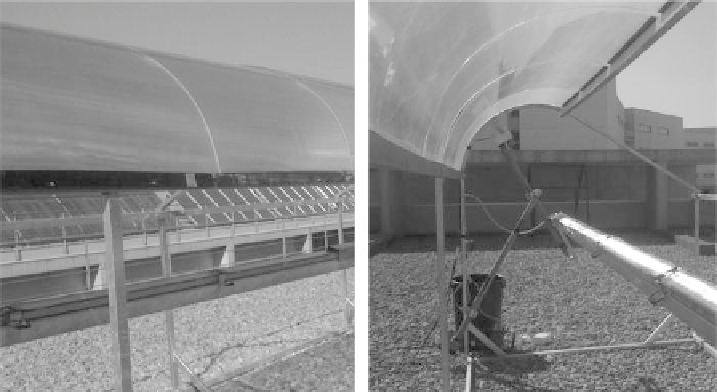Environmental Engineering Reference
In-Depth Information
Figure 17.2.10
Linear Fresnel lens concentrating system developed at the University of Lleida. Right:
detail of the concentrated spot on the PVT receiver.
input radiation onto a small moving focal area which, in turn, is tracked by the PV
receiver. Following this approach, the University of Lleida has developed a prototype
(Figure 17.2.10) based on a stationary Fresnel lens which focuses solar radiation onto
a PVT receiver which tracks the moving focal area (Chemisana and Ibañez, 2010). The
advantages of this type of CPV make it architecturally versatile, allowing integration
onto flat or inclined roofs or as lightweight façades, windows etc. Thus, their character-
istics correspond perfectly to the requirements of well-integrated systems described by
the IEA PVPS Task 7 workgroup (Luque-Heredia et al., 2007; Tripanagnostopoulos,
2008).
Refractive systems under high- and medium-concentration ratios are summarized
in Table 17.2.3.
17.2.3.3 Low concentration systems (C
<
10X)
Within this group fall an extremely large number of systems and variations based on
very distinct technologies.
From an intuitive point of view, the simplest system is the V-trough reflector
which directs light onto the receiver using flat mirrors (Tabor, 1958; Hollands, 1971;
Fraidenraich, 1998a; Rabl, 1976a; Fraidenraich and Almeida, 1991). The V-trough
can achieve at most 3X concentration. To ensure uniform illumination of the PV
cells, planar reflectors require solar tracking (Freilich and Gordon, 1991; Gordon
et al., 1991; Klotz et al., 1995; Fraidenraich, 1998b; Klotz, 2000; Poulec and Libra,
2000; Dobon et al., 2001). If solar tracking is not continuous, the V-trough behaves
as an anidolic (non-imaging) optical system. Use of such devices, as with all low-
concentration systems, is beneficial as commercial cells may be used and as cell heating
is reduced (King et al., 2000; Klotz et al., 2001). However, despite the low light flux,

Search WWH ::

Custom Search